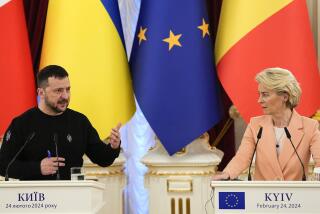BREAKUP OF THE SOVIET UNION : It’s Official: Independence for the Baltics
- Share via
The History
Official recognition of independence for the three Baltic states ends a struggle by Lithuania, Latvia and Estonia since their annexation by the Soviet Union on the eve of World War II. But their history involves centuries of both Germanic and Russian domination.
* Independence for the three provinces of imperial Russia came with the Treaty of Versailles after World War I. They remained independent between the two world wars, but with tension building they were occupied by the Germans in 1939.
* The secret 1939 Molotov-Ribbentrop pact between Josef Stalin and Adolf Hitler allowed the Soviet Union to swallow them as republics in August, 1940.
* The Germans invaded again in 1941, occupying all three Baltic states until the Nazis capitulated to allied forces.
* The Soviet Union took over the three states again, though their annexation was never officially recognized by the United States.
* The fight against their status continued, but flagged in 1975, when the Helsinki Accords set down the principle of respect for established borders.
* Last year, Lithuania declared sovereignty in March and announced it would secede. Moscow clamped restrictions on it, and Lithuania delayed its declaration. Estonia and Latvia followed its lead, with both voting to observe a transition period.
* This year, there were renewed efforts at separation, with refusals to sign or draft a proposed Union Treaty to define relations between the republics and Moscow. That treaty proposal was among the factors triggering the failed coup to oust President Mikhail S. Gorbachev on Aug. 19. Upon the coup’s collapse, Lithuania, Latvia and Estonia immediately proclaimed independence.
The Numbers
* LITHUANIA:
--The largest and most populous of the three republics that lie on Baltic Sea. It covers 26,080 square miles and has 3.7 million inhabitants, Lithuania is bounded by Latvia, Byelorussia and Russia and has a short frontier with Poland.
--Lithuanians total about 80% of the population, making it the Baltic republic with the highest percentage of its titular nationality. About 9% are Russian, 7% Polish and 2% Byelorussian.
--It is poor in natural resources, importing all its gas and oil from the Soviet Union, so it will need to international assistance and cooperation to survive.
--Capital: Vilnius.
ESTONIA:
--Located across the Gulf of Finland from Finland and bounded on the east by the Russian Federation, Estonia is the smallest of the Baltics, covering only 18,040 square miles.
--About two-thirds of its 1.6 million inhabitants are ethnic Estonians, who speak a language related to Finnish. Russians make up 28% of the population.
--Fishing, shipbuilding and farming are key industries.
--Capital: Tallinn.
LATVIA:
--Sandwiched between Lithuania and Estonia and bordered on the east by Russia and Byelorussia, Latvia is the most Russified of the Baltic republics. It covers 25,480 square miles.
--About 54% of its 2.7 million residents are ethnic Latvian, 33% are Russian, 5% are Byelorussian, 3% are Poles and 3% are Ukrainians.
--Latvia is the most industrialized of the Baltic republics, manufacturing railroad equipment, chemicals, textiles and electronics, and has a large, comfortable middle class.
--Capital: Riga.
The Problems
* Economy. All three states must free prices and move to privatize state-owned enterprises, which still account for the bulk of their economies. Latvia, for example, has taken over the republic’s branch of the Soviet state bank. Creating separate currencies will be difficult, especially because the Soviet ruble is not convertible to foreign currencies and is declining in value.
* Professionals. A big problem with economic reform will be a lack of trained professionals in business, banking and international finance.
* Soviet Troops. While the independence announcement has been made, actual separation will require negotiation over the removal of Soviet troops. Officials estimate there are about 250,000 Soviet troops in Lithuania, Latvia and Estonia. They have varying ideas about what is a reasonable withdrawal period.
* Western Aid. After the collapse of Communist rule across the former Soviet Bloc, the United States stepped up aid in the form of credits and loans aimed at helping stabilize the nations’ currencies and made available technical assistance. Poland and Hungary also received direct aid from the United States, although in small amounts. The U.S. will be pressured for some direct aid of the type that the Administration has hesitated to provide to the Soviet Union.
* Borders. Some have suggested that once Soviet troops are gone, the Baltics will lack the manpower or expertise to handle problems such as drug-trafficking. And the rules for Soviet use of Baltic ports through which a large percentage of Soviet imports pass, must also be decided.
* Land. Lithuania wants to keep regions gained under Soviet rule that were formerly part of neighboring Poland and Soviet Byelorussia, including the capital Vilnius, rather than revert to 1939 borders. And the Baltics want an apology as acknowledgement of illegal Soviet occupation of their lands.
More to Read
Sign up for Essential California
The most important California stories and recommendations in your inbox every morning.
You may occasionally receive promotional content from the Los Angeles Times.













